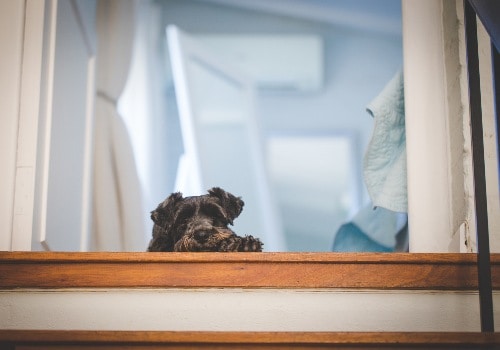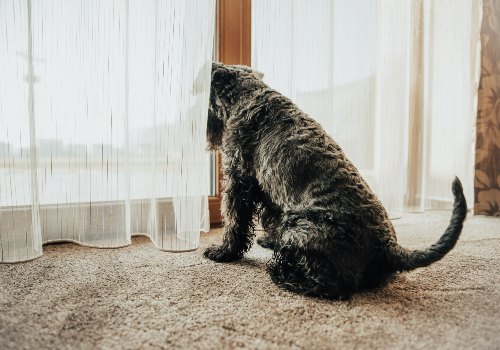Whether you’re leaving for work, going on vacation, or just running to the store, your dog freaks out when you leave the house without him. Why do dogs get separation anxiety when their owners leave — and what can be done about it?
Separation anxiety is a legitimate medical condition that’s easier to understand when it’s viewed from a dog’s perspective. Let’s enter the canine mind and find out the truth about separation anxiety.
Dogs and Separation Anxiety: Questions and Answers
What Is Separation Anxiety?
It’s normal for your dog to feel a little sad when he doesn’t get what he wants. And that’s especially true when what he wants is to spend time with you.
Most of the time, this sadness lasts just a few minutes before the dog gets distracted or adjusts to being alone for a bit.
But for some dogs, being separated from their owners is so distressing that they lose control of their emotions and behaviors. They act out, destroy things and even injure themselves, and they typically only calm down when their owners return.
This is separation anxiety — an out-of-control stress response to being away from their owners. It goes beyond brief sadness and boredom, crossing the line into a seriously debilitating state of panic.
What Are the Signs of Separation Anxiety?

Many people, upon noticing their dogs following them around the house or whimpering a little when they’re left alone, diagnose their pets with separation anxiety. But these behaviors are totally normal when they’re short-lived.
True separation anxiety is unmistakable. Dogs with separation anxiety will attach themselves to one person and become incredibly destructive when that person isn’t around.
The behaviors caused by separation anxiety vary from dog to dog. They often include incessant vocalizations (barking, whining, yelping, crying), chewing themselves or other objects, pacing, eating non-food items, peeing or pooping themselves, and trying to escape.
Once the dog’s loved one returns, the bad behavior gets dramatically better or stops entirely. But the next time the person leaves, the anxious response is triggered, and the cycle repeats itself.
Separation anxiety episodes are comparable to panic attacks in humans. The dog may experience an increased heart rate, shortness of breath, frantic movements, loss of coordination, and excessive drooling.
Dogs with separation anxiety often hurt themselves during their episodes, whether from scratching the door until their paws bleed or biting their legs raw. Owners have even reported their dogs throwing themselves through windows during a panic-fueled escape attempt.
Every dog is different, so your dog may exhibit behaviors and symptoms other than those listed. The unifying factor in all cases of separation anxiety is a prolonged, intense stress response that’s alleviated by the return of the dog’s loved one.
What Causes Separation Anxiety?
Like most psychological conditions, separation anxiety has many potential causes, and we don’t fully understand all of them.
It’s believed that there is a genetic component to separation anxiety: dogs whose parents had separation anxiety are more likely to have it themselves. But the disorder can also present itself in dogs with no family history of anxiety.
A dog’s environment also seems to play a role in separation anxiety, especially the environment that the dog grew up in. Dogs who grew up in shelters, on the streets, or in abusive homes are more likely to have separation anxiety later in life.
Even if a dog grew up in a loving home, various life events could trigger separation anxiety.
The arrival of a new baby, for instance, could disrupt the dog’s routine, overwhelm his senses and reduce the amount of attention he gets. This combination of stressors could be too much for him to handle, causing a mental break and subsequent separation anxiety.
What Goes Through a Dog’s Mind During Separation Anxiety?

We may never know for sure exactly what a dog thinks and feels, but dog behaviorists have a few theories.
Some dogs with separation anxiety may be struggling with a fear of abandonment. If they were previously given up for adoption or abandoned, they may be remembering their traumatic pasts every time their owners leave.
Reliving those moments puts the dog into “fight-or-flight” mode, a state of panic in which the dog attempts to flee from or attack the source of the panic. But since the source is the dog’s own mind, the result is extreme behavior and destruction.
Dogs with separation anxiety may also be unable to deal with change. In these cases, the dog defines “normal” as “my owner is here,” — and when the owner leaves, the situation is no longer normal.
Here, the dog may not worry that his owner is never coming back, but he may not know what to do with himself in the meantime. Without his owner to guide his behavior and activities, he becomes distressed and acts out.
What Can I Do About My Dog’s Separation Anxiety?
Many owners, when dealing with separation anxiety,
Anti-bark collars and crates, for instance, stop excessive barking and prevent your dog from destroying your home. But the underlying anxiety will still be there and may become even worse if the dog can’t cope with it the way he’s used to.
Other measures, like getting a second dog or distancing yourself from your dog while you’re home, can exacerbate the problem as well. You need to
For mild separation anxiety, try giving your dog a puzzle toy filled with treats, then leave the house for 20 minutes or so. This will occupy your dog’s mind and help him associate being away from you with good things (toys and treats).
More drastic cases may require professional help from a vet and/or a dog behaviorist.
A dog behaviorist can help you put together a desensitization plan to slowly acclimate your dog to being alone. Individualized help is very important here, as every dog is different.
Anti-anxiety medication and antidepressants may also help soothe your dog’s anxiety. A vet can assess your dog and prescribe medication if necessary.
If you’ve tried all of these measures and your dog still has anxiety, you may have no choice but to find creative ways of bringing him (or her) along for the ride. Here’s an article that outlines reasons to go camping with your dog. Maybe that’d be a good first start.

I’ve seen this several times in chronically ill daycare dogs. They have a “regroup and rebound” day where they come in suddenly with a spring in their step, seek out and visit their favorite friends, have a brightness in their eye and gaze fondly at everyone, participating as they can. Then the last crash within a day or two. Now we know when we see the “rebound” and there are many tear filled eyes that last good day.